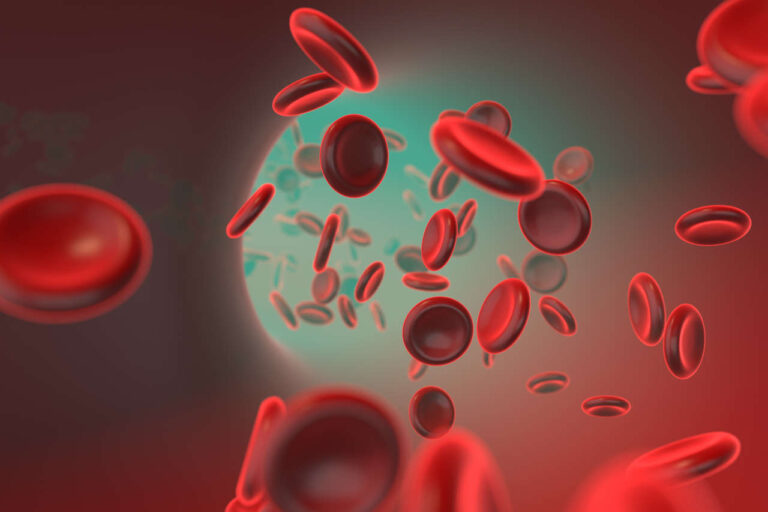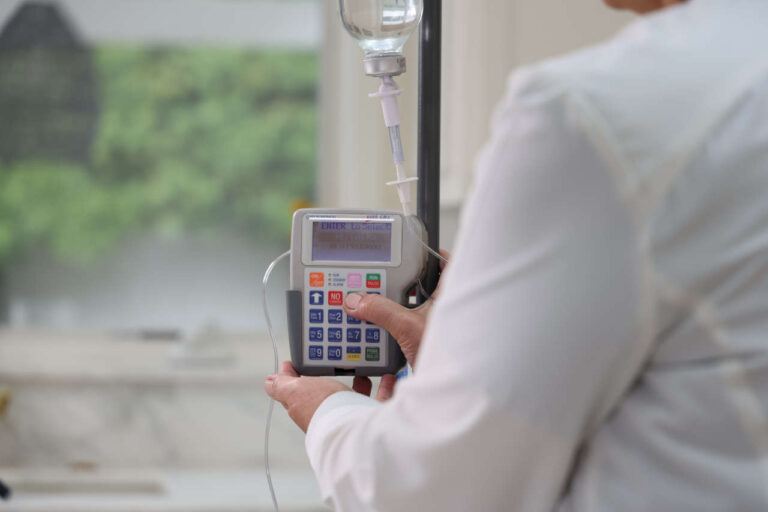
Neonatal hemochromatosis (NH) is an extremely rare and life-threatening condition that causes damage to the liver of a developing fetus. Babies with neonatal hemochromatosis are often born prematurely (very early) or struggle to grow normally in the womb during pregnancy.
Get Your IVIG Dose – At-Home Infusion
If left untreated, this condition can lead to stillbirth late in pregnancy or newborn death after birth due to severe liver injury and iron accumulation in the body.
IVIG therapy has been successfully introduced to improve the outcomes of neonatal hemochromatosis and can be used as a prenatal (during pregnancy) and postnatal (after childbirth) treatment.
This article reviews the basics of neonatal hemochromatosis, how it occurs, and how IVIG can be used as a novel therapy to treat newborns diagnosed with NH and improve the survival rate of the fetus in pregnant women with a history of NH in previous pregnancies.
Neonatal Hemochromatosis: Brief Overview
Hemochromatosis is a condition that describes the excessive accumulation of iron in the body. In adults, it is usually genetic (known as hereditary hemochromatosis) and progresses slowly. However, neonatal hemochromatosis is an immune-mediated condition that occurs during pregnancy (typically in the fourth month).
The fetus in the womb develops advanced liver injury due to maternal-fetal alloimmunity, which ultimately leads to the accumulation of iron in the body and other organs like the pancreas, heart, and endocrine glands.
To understand the role of IVIG in treating NH, let’s first briefly review what exactly causes neonatal hemochromatosis.
Causes of Neonatal Hemochromatosis
Numerous research evidence indicates that in 95% of cases, neonatal hemochromatosis is caused by maternal-fetal alloimmunity, a condition termed gestational alloimmune liver disease (GALD), in which the maternal antibodies attack the fetus’s liver cells during the pregnancy.
Link of Maternal-Fetal Alloimmunity with Neonatal Hemochromatosis
In a healthy pregnancy, the mother’s immune system produces IgG antibodies (maternal antibodies) that travel through the placenta to protect the fetus from infection.
In some cases, these maternal antibodies, instead of protecting the fetus (baby), mistakenly identify the fetus cells as “foreign” and start attacking them, causing fetal injury. This is referred to as “maternal-fetal alloimmunity.”
In GALD (which is the underlying cause of NH), the maternal antibodies specifically target the fetus’s liver cells (hepatocytes) during pregnancy, ultimately causing liver injury or damage. This damage causes iron to build up in the fetus’s body, leading to symptoms of neonatal hemochromatosis.
Simply put, NH results from the mother’s immune system attacking the baby’s liver during pregnancy because of GALD.
It is estimated that if your past pregnancy ends in NH or your first child is born with neonatal hemochromatosis, there is approximately a 90% chance that your next child will have the same condition.
Therefore, prenatal and postnatal treatments are recommended to ensure the delivery of a healthy baby and to improve the survival rate of newborns with neonatal hemochromatosis (NH) without requiring liver transplants.
Get IVIG Copay Assistance
How Can IVIG Help Manage Neonatal Hemochromatosis?
IVIG therapy has proven to improve the outcome of NH when used as prenatal and postnatal treatment.
1. Use of IVIG as a Prenatal Treatment (During Pregnancy)
Treatment with IVIG therapy can prevent the recurrence of NH during pregnancy. For instance, a case report of a 32-year-old woman with a history of NH in previous pregnancies delivered a healthy baby after receiving IVIG therapy (at a dose of 1 mg/kg) weekly in the third trimester until the end of pregnancy.
Similarly, various other case studies reported that receiving IVIG therapy at 14 weeks, 16 weeks, and weekly from the 18th week until the end of pregnancy can prevent the recurrence of NH and increase the survival rate of the baby.
Working Mechanism of IVIG as a Prenatal Treatment
IVIG therapy as a prenatal treatment can help to modulate the mother’s immune response during pregnancy. It does this by:
- Neutralizing the effect of maternal antibodies that pass from the mother to the fetus and damage the liver cells
- Reducing the inflammation that damages the liver
- Blocking the activation of the complement cascade (a component of the innate immune system) that attacks the fetal liver cells
2. Use of IVIG as a Postnatal Treatment (After Childbirth)

For newborns diagnosed with NH, IVIG can be used as a part of their treatment plan to stop further liver damage and reduce the need for a liver transplant. Recent studies demonstrate that IVIG therapy can block the antibodies’ action and interfere with complement cascade activation to prevent severe liver failure in infants with NH.
According to research results, the outcome (survival rate without liver transplantation) improved from 17% to 75% in infants treated with exchange transfusion (ET) and four doses of IVIG. Similarly, in another case report of 50 infants with NH, when treated early with IVIG, their survival rate without liver transplantation increased by 80%.
Working Mechanism of IVIG as a Postnatal Treatment
As a postnatal treatment, IVIG therapy works to prevent complications like multi-organ failure, stop ongoing liver damage, and improve the survival rates of infants.
The rate of occurrence and deaths dramatically decreased among neonates with NH after the administration of IVIG as a preventive therapy.
Speak to a Specialist
About Copay AssistanceWhat Is the Typical Dosage of IVIG for NH?
IVIG is administered intravenously in a hospital setting over a period of hours. According to some literature, IVIG can be given at a dose of 1g/kg to patients with neonatal hemochromatosis. However, depending on the patient’s health, the newborn’s weight, and the severity of the condition, the doses can be adjusted.
Takeaway
In summary, neonatal hemochromatosis can be effectively managed with prenatal treatment and early postnatal IVIG injection as it decreases the severity of symptoms, averts liver failure, and avoids the need for a liver transplant.
If you or someone you know has lost a baby prematurely due to neonatal hemochromatosis or is at higher risk of NH recurrence, IVIG treatment can help manage this condition. Early diagnosis of NH and administration of IVIG in newborns with NH can achieve positive outcomes for affected families.
REFERENCES:
- Lopriore, E., Mearin, M. L., Oepkes, D., Devlieger, R., & Whitington, P. F. (2013). Neonatal hemochromatosis: Management, outcome, and prevention. Prenatal Diagnosis, 33(13), 1221-1225. https://doi.org/10.1002/pd.4232
- Mugarab-Samedi, V., Ryan, M. D., Al Awad, E. H., & Elsharkawy, A. (2021). The Effect of Prenatal and Postnatal Treatment with Intravenous Immunoglobulin on Severity of Neonatal Hemochromatosis: The Tale of Two Brothers (Case Report). AJP Reports, 11(2), e102. https://doi.org/10.1055/s-0041-1731311
- Feldman, A. G., & Whittington, P. F. (2013). Neonatal Hemochromatosis. Journal of Clinical and Experimental Hepatology, 3(4), 313. https://doi.org/10.1016/j.jceh.2013.10.004
- Rand, E. B., Karpen, S. J., Kelly, S., Mack, C. L., Malatack, J. J., Sokol, R. J., &Whittingtonn, P. F. (2009). Treatment of Neonatal Hemochromatosis with Exchange Transfusion and Intravenous Immunoglobulin. The Journal of Pediatrics, 155(4), 566-571.e1. https://doi.org/10.1016/j.jpeds.2009.04.012
- Moorhead, R., Dean, J., & Brennecke, S. (2022). Successful pregnancy outcomes following intravenous immunoglobulin treatment in a woman with a previous fetal death in utero due to gestational alloimmune liver disease: A case report. Case Reports in Women’s Health, 35, e00419. https://doi.org/10.1016/j.crwh.2022.e00419
- Park, G. Y., Song, J. I., Lee, S. H., Oh, S. H., Hong, H. S., & Kim, S. S. (2022). Gestational alloimmune liver disease treated with exchange transfusion and intravenous immunoglobulin: A case study. Transfusion and Apheresis Science, 61(3), 103347. https://doi.org/10.1016/j.transci.2021.103347
- Neonatal hemochromatosis – Stanford Medicine Children’s Health. (n.d.). https://www.stanfordchildrens.org/en/services/fetal-and-pregnancy-health/conditions/neonatal-hemochromatosis.html
- Whittington, P. (2013). Gestational alloimmune liver disease and neonatal hemochromatosis. Seminars in Liver Disease, 32(04), 325–332. https://doi.org/10.1055/s-0032-1329901













